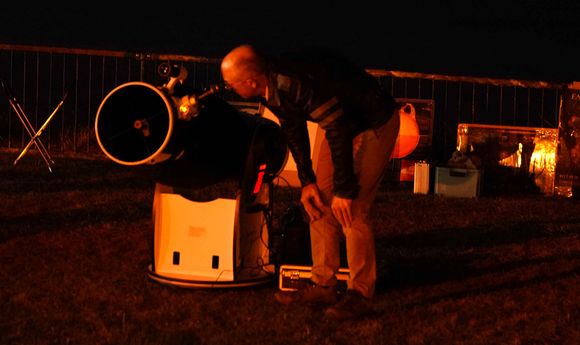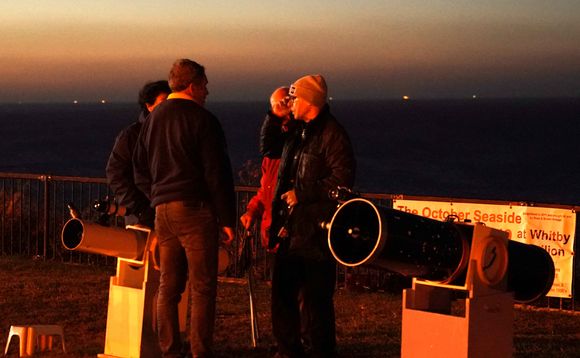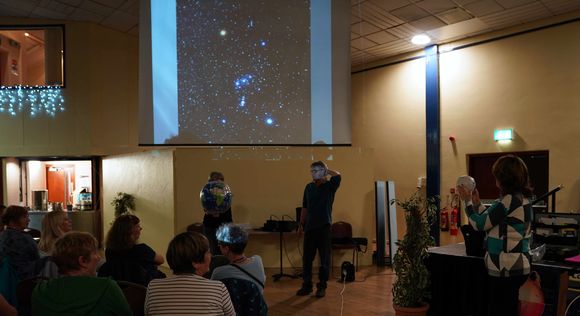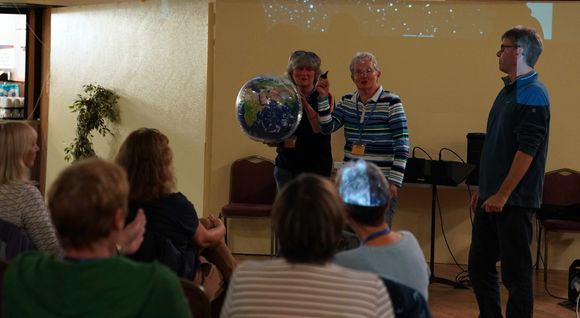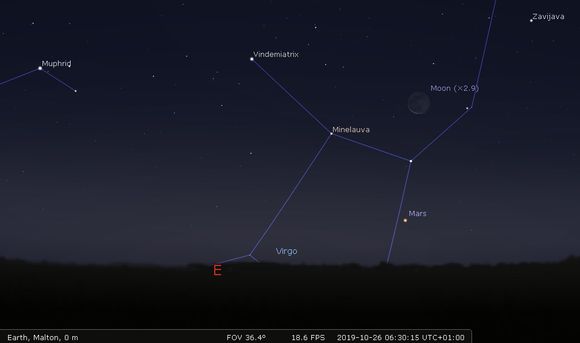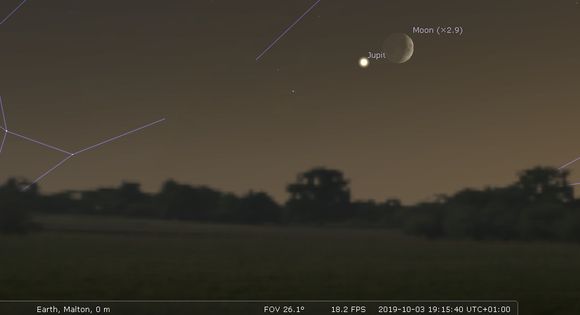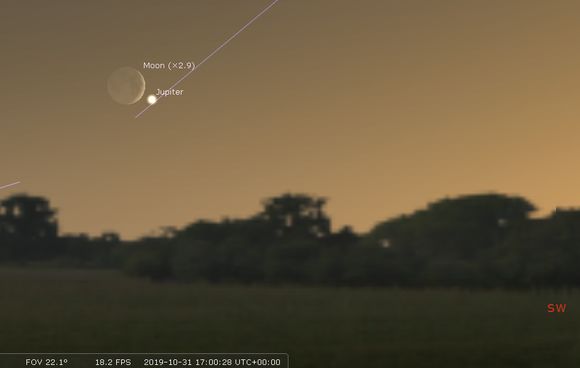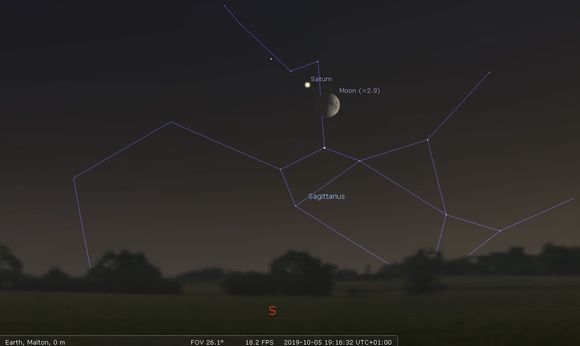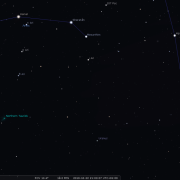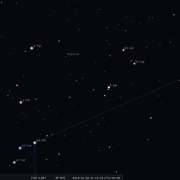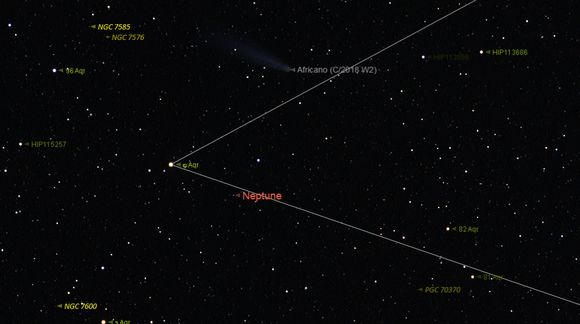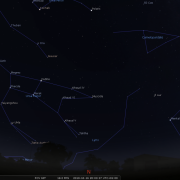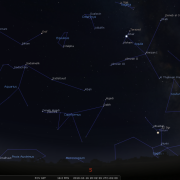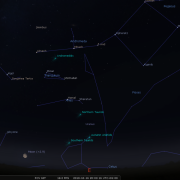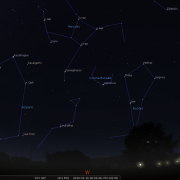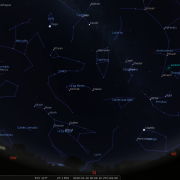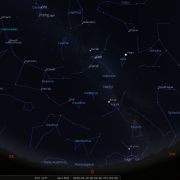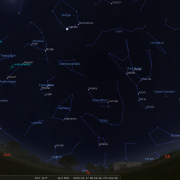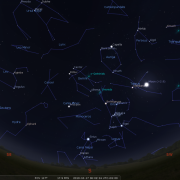Welcome to the WDAS monthly newsletter for October 2019: a digest of the month's latest contributions to our website. Below you'll find Society News: past and coming events, a review of the season, possibility of free food?, and your monthly Sky Notes.
Don't forget: The first Society Meeting of the new Winter Season will be tonight, 1st October, at Whitby College.
Society News
 The society is delighted to announce its involvement in the inaugural Star Gazing weekend, hosted by Vicky and Colin of the Fox and Hounds, Ainthorpe, near Danby.
The society is delighted to announce its involvement in the inaugural Star Gazing weekend, hosted by Vicky and Colin of the Fox and Hounds, Ainthorpe, near Danby.
This event is now running on Saturday October 19th only, from the Fox and Hound Inn and will commence from around 5pm. The evening will start with an indoor presentation and weather permitting will then continue outdoors with demonstrations and observations, hopefully of the wonderful autumn night sky above the North York Moors.
Having checked out the location and sites to be utilised, the viewing aspects and lack of light pollution should make for fantastic viewing, whether through a telescope, binoculars or just the naked eye. Vicky and Colin from the Fox and Hounds have asked the society to host the star party events as well as giving indoor presentations for the people staying in the inn for the weekend.
Evening Dinner at a discounted rate can be provided for those members assisting with the event, ie. transport, telescopes and other equipment, but this will be dependent on numbers as places are limited, so please contact Mark at the earliest opportunity if you are intending to come along. For further information please click this link.
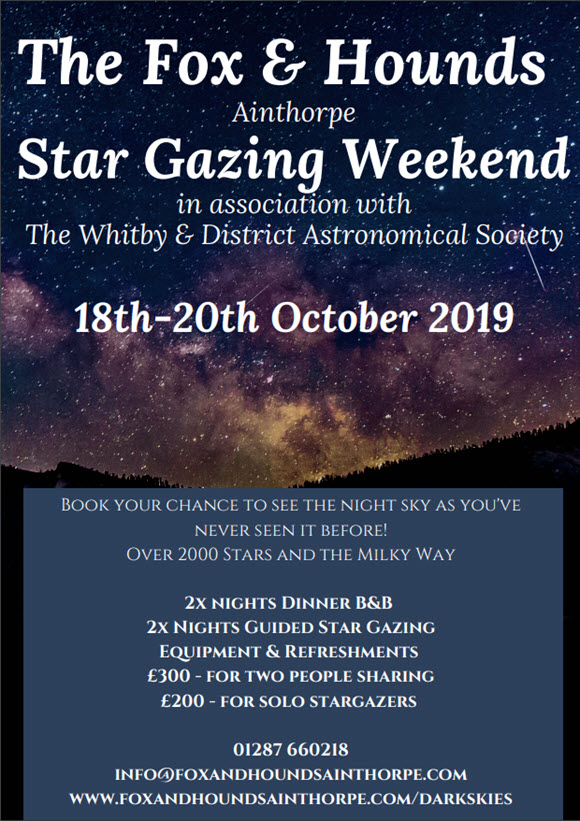
Early weather forecasts for the Hooks house event initially looked rather unfavourable, however, predicted heavy showers failed to materialise and by late afternoon it looked more likely skies would clear and so it proved.
It was not though the balmy conditions we had enjoyed just a week earlier for the bank holiday, the northern air mass brought with it a decided chill, the kind that a warm padded coat only alleviated.
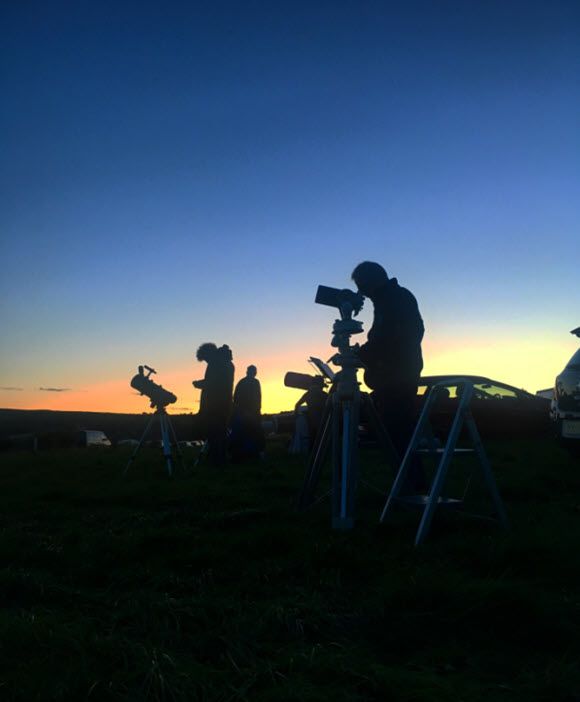
Having already dropped off a couple of telescopes at Hook’s house during the afternoon, there was enough additional transport on hand in the evening (Barbara and Mark and Lee) to ferry over the remaining instruments and personnel to the campsite, where we were joined by Paul Wood and his daughter as well as Paul Cass.
Having set up the equipment on the adjacent field to the main campsite, the six scopes deployed, including the LX 200 complete with new hand controller, keith’s GOTO dobsonian, the two ‘non goto’ dobs already left on site, together with John L’s scope, Lee’s reflector and Paul woods scope, all made for an impressive, array. Certainly enough aperture to fully exploit the transparent skies. The campsite was almost full, and once word filtered around the field, a decent sized crowd began to gather behind the instruments.
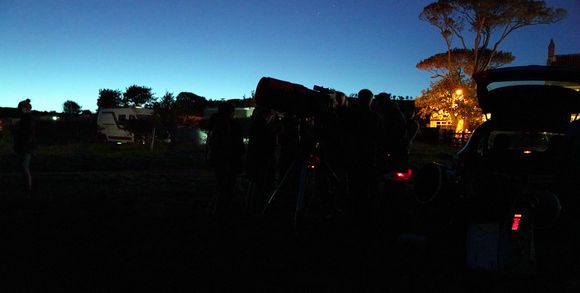
The two main visible planets; Saturn and Jupiter, were naturally our first targets, both showing detail not apparent from the West Cliff. It came as no surprise that people were bowled over by the vista, after all, who tires of the rings of Saturn? One major difference from the previous week, when the observing location had been from the west cliff, was the superb appearance of deep sky objects. Little scrutiny was required through the eyepiece to appreciate the selected deep sky wonders. The Ring Nebula, Dumbbell, M13, M31, the double cluster, M11, M92, M5, M15, et al, all were so much brighter. Perhaps best of all was the unmistakable soft glow of the Milky Way, which could be traced from horizon to horizon with the , dark the northern rift in Cygnus, clearly evident.
Several laser point tours were conducted, with constellation recognition made so much easier by the dark conditions. By 22:15h, some two hours after the first views of Jupiter, the chill finally began to take its toll thinning out the crowd to the die-hards and late-comers. It had been a rewarding and satisfying evening much appreciated by the campers. Here’s looking forward to next year.
The following three Saturday evening star party events from the West Cliff, had varying success.
The event on the 7th proved reasonable, The following Saturday (14th October) cloud prevented any direct observations although, the rising moon adjacent to the Abbey was a hit with the photographers until it disappeared in cloud.
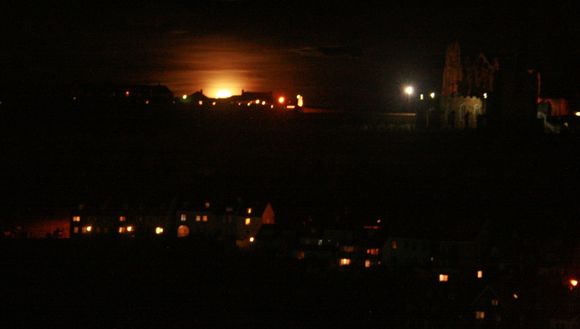
14-Sep-2019: Moon Rise. Photo by Mark. See the Gallery for all Star Party images.
Our final ‘cliff event’ on the 21st went ahead in a brisk breeze, a pity as seeing conditions were excellent, with views of Saturn particular pleasing given its low altitude. Telescope Go-to duties were performed by Keith’s Dobsonian, with Mark’s two manual Dobs also in operation. Public involvement was steady, but not hectic, that said a few new members may have been picked up.
This event was requested over a year ago by the Women’s Institute, but the actual composition and likely format it would follow only emerged on the day itself. In other words the weather decided what was possible on the evening, and although the heavy rain which fell for much of the afternoon had ceased, it was still cloudy!
Plan B was therefore an indoor presentation at their meeting venue, but as this was the main hall of the Whitby Pavilion, it did add another dimension to what was possible.
On arrival Mark and Keith were given a warm welcome by Heather and Mandy in the hall and given time to ‘set up’ the equipment and demonstration aids whilst the ladies saw to WI business for the evening.
Utilising the size of the hall, and with aid from WI members, various scale demonstrations of planetary solar system and stellar distances were performed with much encouragement from the side lines
Following a tea break, in which several rather delicious slices of home baked cake were consumed, our various examples of meteorite and tektites were passed around before Mark a gave a short (for him) power point presentation on the various types of wondrous objects astronomers observe.
We only overran for 5 minutes. It was an enjoyable evening and from later feedback, much appreciated by the WI members, with a few expressing an interest in perhaps joining the WDAS.
With heavy rain showers peppering much of the country, the outlook for the annual Westerdale event did not look overly encouraging.
Having packed a couple of the manual ‘Dobs’ into Mark’s Car; just in case, together with all the ‘plan B’ equipment for the indoor presentation, Mark and Keith set off for the Village hall in yet another deluge. It soon became apparent looking at the skies on the way over, that there was a chance of being able to observe something after all.
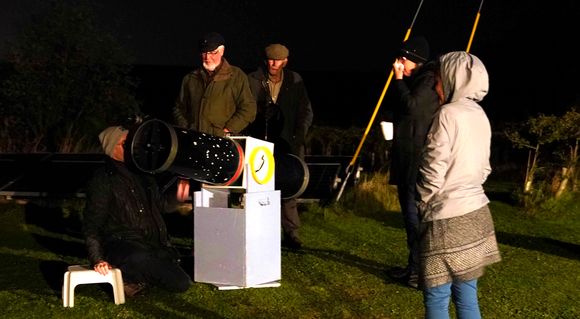
On arrival we were warmly greeted, but deciding it was still too risky erect the scopes outside, we quickly unloaded and set up ‘plan B’ in the hall. It was great to meet fellow member and village elder John Randles again, along with a number of other residents who had come along, not as many as usual, but perhaps the weather had deterred. Utilising the Starry Night Pro program, Mark toured the night sky showing what was visible, but also kept half an eye on the conditions outside. Fortune was with us as skies cleared. The Dobsonians were erected and within 5 minutes or so we were unexpectedly observing Saturn, much to the joy of all attending.
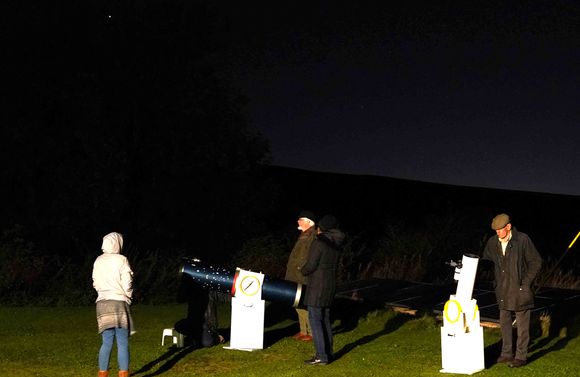
Keith saw a bright meteor and shortly after, another one was witnessed by nearly all present. The ring nebula looked bright and crisp, as did M13 in Hercules. Alberio appeared very colourful and the Andromeda galaxy looked massive, with M32 and 110 very evident. It was undecided as to whether comet Africano W2 was actually spotted through the 10” dob, Mark was sure it was, everyone else said something about spec savers. Another meteor streaked down toward the SW horizon, and as we were packing up, the ISS appeared in the same direction. Things had turned out far better than expected, or foreseen and everyone was highly delighted with the evening. Pity all those who missed out thinking that the weather would be awful. You just never know sometimes.
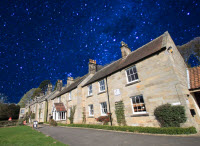 This is part of the Dark Sky festival involving all the North York Moors dark sky sites.
This is part of the Dark Sky festival involving all the North York Moors dark sky sites.
We will be hosting the event for Danby Moors Centre on November 2nd. The public book to attend the event, but places at the Danby Moors Centre are limited to 60. The event is due to start at 18:30h and therefore we are looking to be on site by 18:00h (setting off no later than 17:45h).
Personnel and transportation is therefore requested, as we would like to field 6-8 scopes dependant on the weather. Plan B is always waiting in the wings, ie a presentation indoors. Should the forecast be so awful, the event will be cancelled- though we shall have to wait until a few days before to make sense of the forecasts.
This year’s summer star party season was kind of a reverse to last year. The early and middle parts were particularly plagued by ill-timed spells of unsettled weather, most of which settled over us on scheduled event evenings!
Our Regatta events hardly got off the ground, although strong winds certainly carried plenty of other stuff off the ground. There were no sunspots again and the Perseids were clouded out, as well as subjected to strong moonlight.
Folk week events fared better, but were not vintage, however both the Bank holiday events proved very popular held in very un-bank holiday type conditions.
Hook’s House was excellent and Westerdale. To summarise, well a bit of a struggle really, certainly until late August when matters improved. But it’s only a C- this year
Sky Notes
In this month's Sky Notes:
Planetary Skylights
Jupiter and Saturn remain the most conspicuous evening planets visible, although Neptune and Uranus may be tracked down in the evening sky, but you will probably require a telescope.

 Mars and Venus may be glimpsed with the naked eye, but are not viable telescopic targets this month.
Mars and Venus may be glimpsed with the naked eye, but are not viable telescopic targets this month.

 Jupiter lingers very low in the southwest twilight sky, but will be setting within an hour of the sun by the month’s end. Look for it on the 3rd and again on the 31st when a young crescent moon resides close to Jupiter.
Jupiter lingers very low in the southwest twilight sky, but will be setting within an hour of the sun by the month’s end. Look for it on the 3rd and again on the 31st when a young crescent moon resides close to Jupiter.
Crescent Moon and Jupiter. (Top: 03-Oct-2019 at 19:15h: Bottom: 31-Oct-2019 at 17:00h)
(Click for full-sized images)
 Of lesser prominence (compared to Jupiter) is Saturn, resembling a fairly bright star low in the SSW as dusk falls. It too is gradually edging toward the SW, sitting just to the left of the ‘teapot’ asterism in Sagittarius. If you can observe with a telescope, do so early in the month when Saturn is at least a reasonable distance above the horizon. Wait for those steady ‘seeing’ moments to appreciate the ring system which remains well orientated. Look also for a few of Saturn’s moons, most notably Titan, seen as a bright speck nearby. A waxing crescent moon lies nearby Saturn on the 5th.
Of lesser prominence (compared to Jupiter) is Saturn, resembling a fairly bright star low in the SSW as dusk falls. It too is gradually edging toward the SW, sitting just to the left of the ‘teapot’ asterism in Sagittarius. If you can observe with a telescope, do so early in the month when Saturn is at least a reasonable distance above the horizon. Wait for those steady ‘seeing’ moments to appreciate the ring system which remains well orientated. Look also for a few of Saturn’s moons, most notably Titan, seen as a bright speck nearby. A waxing crescent moon lies nearby Saturn on the 5th.
 Towards the end of the month Uranus becomes the last of the gas giant planets to reach opposition this year. Although not a naked eye object for the majority of people, keen sighted observers viewing from a dark location may be able to spot it (assuming they know exactly where to look). Uranus resides just within the borders of Aries, but is some distance below the ‘crooked line’ asterism of the Ram. If you have a constellation chart or App etc, use Mesarthim and iota Aries as pointers to locate Uranus, which resides 3 times the distance between these stars, below them. Aries is located due east around 20:00h mid October. Through binoculars Uranus resembles a rather faint star of subtle grey/green hue. You will require a telescope to discern its tiny disk.
Towards the end of the month Uranus becomes the last of the gas giant planets to reach opposition this year. Although not a naked eye object for the majority of people, keen sighted observers viewing from a dark location may be able to spot it (assuming they know exactly where to look). Uranus resides just within the borders of Aries, but is some distance below the ‘crooked line’ asterism of the Ram. If you have a constellation chart or App etc, use Mesarthim and iota Aries as pointers to locate Uranus, which resides 3 times the distance between these stars, below them. Aries is located due east around 20:00h mid October. Through binoculars Uranus resembles a rather faint star of subtle grey/green hue. You will require a telescope to discern its tiny disk.
 Neptune reached opposition last month residing in the constellation of Aquarius close by the star Phi aqr. You will require a telescope to spot its diminutive disk, which is fainter than all visible naked eye stars, but it does appear decidedly blue grey in hue. It is now moving away from Phi aqr.
Neptune reached opposition last month residing in the constellation of Aquarius close by the star Phi aqr. You will require a telescope to spot its diminutive disk, which is fainter than all visible naked eye stars, but it does appear decidedly blue grey in hue. It is now moving away from Phi aqr.
Meteors

- The Orionids (Oct 16- 27) are the month’s most reliable shower, peaking this year on Oct 21/22. Prospects are better than last year, as the moon will be at last quarter, but there will still be interference from moonlight. The peak rate of 20-25 will be reduced a little to perhaps a dozen. Like the May Eta Aquarids, Orionids are associated with Comet Halley, but are more favourable for northern hemisphere observers due to the radiant being situated high in the South by early morning hours. Orionids are swift moving, often producing persistent trains.
- The Southern Taurids peak on the 10th, however rates will be little more than sporadic levels (5 per hour) and a gibbous moon will drown out all but the brightest.
- The weak Piscid shower has three peak dates, Oct 13th being the optimum, however this is a full moon date, so few will be witnessed. Observed rates are little better than sporadic levels - around 3-7 per hour. Piscid meteors are often slow, of long duration, but not very brilliant.
- Perhaps the most interesting shower is the Giacobinids or Draconids (Oct 6 -10th peaking on the 8th) which are associated with the periodic comet Giacabini-Zinner (6yrs) The shower is very erratic, but can produce outbursts of activity. This year evidence from the BAA and IMO again suggests that this may be the case. Observing over the night of the 8th, rates exceeding 25 per hour are possible in the early morning hours and with no moonlight present an observer is likely to see at least a dozen. The Draconids; associated with the constellation of Draco, which is located high up in the NW winding its way between the two celestial bears of Ursa Major and Minor.
Comet 2018 W2 (Africano)
Although not a naked eye object, W2 is still well placed in the evening sky for northern hemisphere observers. Around mag +9.8 it is visible in 10X50 or above binoculars or a telescope. The comet was closest to Earth on Sept 27th and is now moving rapidly southward through Pegasus, Pisces, and into Aquarius before slowing in to Piscis Austrinus by mid-October. The comet is then expected to fade. It passes by Neptune on the 3rd Oct. More detailed charts will be shown at the October meeting on the 1st.
October 2019 Sky Charts
|
Looking North
Mid-October - 20:00h |
Looking South |
|
Looking East
Mid-October - 20:00h |
Looking West
Mid-October - 20:00h |
|
Northern Aspect
Mid-October - 20:00h |
Southern Aspect
Mid-October - 20:00h |
| Looking North (Early) Mid-October - 06:00h |
Looking South (Early) Mid-October - 06:00h |
Additional Image Credits:
- Planets and Comets where not otherwise mentioned: NASA
- Sky Charts: Stellarium Software
Events
 Observe the night sky with us at the Bruce Observatory, Whitby School
Observe the night sky with us at the Bruce Observatory, Whitby School
Observing Nights are held weather permitting: check for a relatively clear sky before leaving home. If in doubt, Mark can be reached on 07886069339
Please note the college drive gate is now operated via a electronic key code - so anyone wishing to attend must be at the car park at the top of the drive by 19:00hrs - unless an arrival time has been arranged with Mark/Keith.
 Observe the night sky with us at the Bruce Observatory, Whitby School
Observe the night sky with us at the Bruce Observatory, Whitby School
Observing Nights are held weather permitting: check for a relatively clear sky before leaving home. If in doubt, Mark can be reached on 07886069339
Please note the college drive gate is now operated via a electronic key code - so anyone wishing to attend must be at the car park at the top of the drive by 19:00hrs - unless an arrival time has been arranged with Mark/Keith.
 Observe the night sky with us at the Bruce Observatory, Whitby School
Observe the night sky with us at the Bruce Observatory, Whitby School
Observing Nights are held weather permitting: check for a relatively clear sky before leaving home. If in doubt, Mark can be reached on 07886069339
Please note the college drive gate is now operated via a electronic key code - so anyone wishing to attend must be at the car park at the top of the drive by 19:00hrs - unless an arrival time has been arranged with Mark/Keith.
 Whitby School - Room H1.
Whitby School - Room H1.
In Members' monthly meetings we usually take a tour of the night sky for the coming month using the Planetarium program. Have talks and presentations on various topics of astronomy/space etc, and discuss future events etc. New members welcome.
 Observe the night sky with us at the Bruce Observatory, Whitby School
Observe the night sky with us at the Bruce Observatory, Whitby School
Observing Nights are held weather permitting: check for a relatively clear sky before leaving home. If in doubt, Mark can be reached on 07886069339
Please note the college drive gate is now operated via a electronic key code - so anyone wishing to attend must be at the car park at the top of the drive by 19:00hrs - unless an arrival time has been arranged with Mark/Keith.
 Observe the night sky with us at the Bruce Observatory, Whitby School
Observe the night sky with us at the Bruce Observatory, Whitby School
Observing Nights are held weather permitting: check for a relatively clear sky before leaving home. If in doubt, Mark can be reached on 07886069339
Please note the college drive gate is now operated via a electronic key code - so anyone wishing to attend must be at the car park at the top of the drive by 19:00hrs - unless an arrival time has been arranged with Mark/Keith.


